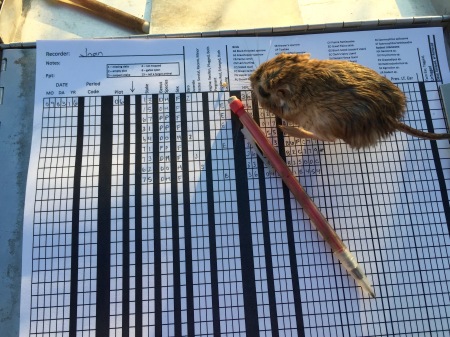Funded by the National Science Foundation to study the importance of competition and granivory in desert ecosystems, the Portal Project first started collecting data in the summer of 1977. The initial grant was just for 5 years, yet 40 years later the site is still collecting data on plants, rodents, and weather.
To our friends who study paleoecology, 40 years is an eyeblink but in the span of a human life, 40 years is a long time. As you might expect, much has changed on the project. For one thing, after 40 years, the team running the site has changed. The original team of scientists, Jim Brown, Dinah Davidson, and Jim Reichman have all retired from the daily challenges of training students and writing grants, though some are still doing science. In their place, Tom Valone and I do our best to keep things running, studying the mysteries of the desert, and training the next generation of scientists who will hopefully take our place.
But more than just the people have changed. The site has changed too. It was easier to gaze across the site back then, before the Acacia went wild and started to take over.

Left: Jim Brown in the late 1970s at the site (unknown photographer) Right: View from the ramada towards plot 1 (photo by Erica Christensen). Not a paired photo, but you get the idea.
The invasive plant, Erodium cicutarium, was a lot rarer back then

You can call Erodium cicutarium, redstem filaree, redstem stork’s bill, or common stork’s bill, but our rodents call it yummy. Photo by Sarah Supp.
And Banner-tailed kangaroo rats (and their distinctive mounds) were abundant.

The distinctive cleared off mound of a Banner-tailed Kangaroo rat. Typically only one individual lives in a mound (unless the kids are still living in mom’s basement). Photo by Sarah Supp.
Our weather data is now recorded by an automated weather station that sends us the data via cellular signals, as opposed to laboriously transcribed from a contraption that would boggle the minds of younger ecologists!

Left: We don’t have any images of the original weather station, but we do have what it produced: large round sheets of paper with squiggles. Right: the new hotness in weather stations. A post about this bad boy will be coming in the future. The previous automated weather station, which is still running as we trouble shoot the new one, is to the left in the image.
But for all the things that have changed, there are many things that remain the same. We still collect data at the same plots at the same stakes using the same methods.

We still use quadrats to count the plants – though quadrat size was decreased to its current state back in the 1980s. Photo by Erica Christensen

The only change to the rodent processing has been the addition of PIT tags and we now process rodents at a central location on their plot. In the early years the number of rodents was lower and processing while picking up traps was common, but this is slow when numbers are high. Photo by Ryan O’Donnell
The site is still intellectually powered by motivated and creative young scientists who are inspired by the place and the data it generates
We still collect data with paper and pencil (though we are debating moving to digital technologies there as well)

The mountains are still stunning

Photo by Glenda Yenni
And, most importantly, the Ramada is still where we gather to share stories, plan the day’s fieldwork, and commiserate over the inevitable challenges of doing fieldwork in a remote, challenging, but amazing location.
To celebrate Portal’s 40th Anniversary, we plan on having a blog a week for the next year (that’s our goal anyway!). These blog posts will focus on the science, the natural history, and the people who have helped make this one of the world’s longest running community ecology experiments.
We have reached out to many of the graduate students and postdocs who have worked at the site over the years asking for memories and stories, but we have not been able to find all of you. If you have a story about Portal or pictures from the site (especially from the early years!) that you’d like to share, let us know in the comments! We have 51 more weeks to fill!




